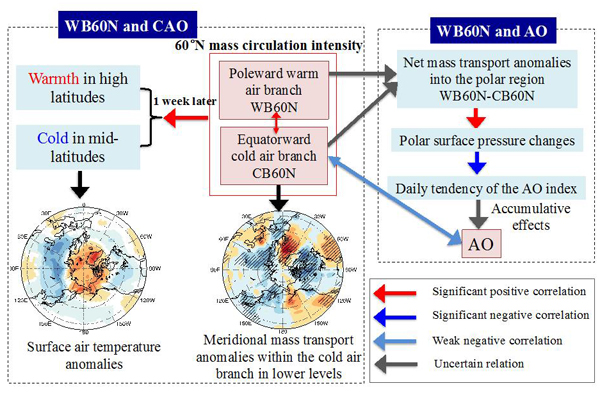Cold air outbreaks (CAO) are frequently occurring severe weather phenomena in winter, which have a serious influence on residents, agriculture, and transportation. Therefore, exploring an effective precursory indicator of CAO and revealing the underlying dynamic and physical processes deserve special attention.
A PhD candidate from Institute of Atmospheric Physics YU Yueyue, supervised by Dr. REN Rongcai, found during her dissertation study that, the Arctic Oscillation (AO) / North Atlantic Oscillation (NAO), which is commonly used as an indicator of CAOs, cannot provide useful information about the timing and intensity of individual CAO events though it can suggest the monthly and yearly average temperature anomalies in mid-latitudes. They worked with Prof. Ming CAI from Florida State University and identified a new precursory indicator of CAOs, the mass circulation index (WB60N), as an effective indicator of CAOs in all timescales.

The schematic diagram of the relation among meridional mass circulation, AO and CAOs. (Plotted by IAP)
They found that the variability of the meridional mass circulation intensity fundamentally controls the occurrence of mid-latitude CAOs, and links the equatorward CAOs to the poleward warm air branch from the tropics in the upper layer or stratosphere. Specifically, the high WB60N index is accompanied by strengthened cold air mass transport through three routes of cold air via East Asia, North America and Central Asia-Eastern Europe, resulting in massive CAOs there one week later.
On the other hand, the variability of the AO is found to be a result of the residual between the poleward and equatorward branches of the mass circulation, thus exhibits large uncertainties in terms of its relationship with the occurrence of CAO events. The mass circulation index is a superior indicator of CAOs than the AO index.
The findings have recently been published in Journal of Atmospheric Sciences and Geophysical Research Letters .
References:
Yu, Y.-Y., M. Cai, R.-C. Ren, and Huug M. van den Dool, 2015: Relationship of Warm Air Mass Transport into Polar Region and Cold Air Outbreaks in Mid-latitudes in Winter. J. Atmos. sci., 72, 349–368. http://journals.ametsoc.org/doi/full/10.1175/JAS-D-14-0111.1?queryID=0%2F804713
Yu, Y.-Y., R.-C. Ren, and M. Cai: Dynamical Linkage between Cold Air Outbreaks and Intensity Variations of the Meridional Mass Circulation, J. Atmos. sci. doi: http://journals.ametsoc.org/doi/pdf/10.1175/JAS-D-14-0390.1
Yu, Y.-Y., R.-C. Ren, and M. Cai, 2015: Comparison of the Mass Circulation and AO Indices as Indicators of Cold Air Outbreaks in Northern Winter. Geophys. Res. Lett., 42, 2442–2448. http://onlinelibrary.wiley.com/doi/10.1002/2015GL063676/full
Contact: D. REN Rongcai, rrc@lasg.iap.ac.cn






